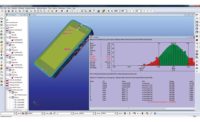Aerospace Back 2 basics
How Closed-Loop Quality can Drive Near-Perfect Compliance in A&D
Quality standards in the aerospace and defense industry are unmatched.




As any large aerospace and defense supplier can attest, quality standards in the A&D industry are unmatched elsewhere in manufacturing. The product complexity, extensive global supply chain, and requisite regulatory burden and government dependence in the industry result in miniscule operating margins and even less room for error in product quality.
Simply put, you have to get it right the first time. And if ever there was an industry perfectly suited to take advantage of the time and money saving benefits afforded by closed-loop quality capabilities, A&D is it.
According to recent research, that’s what leading companies have been doing, as A&D businesses with closed-loop process capabilities are reporting an average improvement of over 3% in product compliance. In this article, we’ll define closed-loop quality processes and establish a technology strategy for ensuring success.
What Is Closed-Loop Quality?
When quality functionalities such as document control, compliance management, non-conformance/corrective and preventive actions (NC/CAPA), audit management, and others are built into other critical business processes, a two-way flow of information can be created across functions that enable end-to-end visibility into quality across the value chain.
We refer to this as “closed-loop quality,” and it’s critical to identifying and resolving quality issues and defects closer to their source. The faster a potential quality issue can be identified and addressed, the easier it will be to address from a compliance standpoint and the less it will impact the overall cost of poor quality. As you can imagine, this goes a long way in addressing the aforementioned challenges of the A&D industry.
Some of the ways leading A&D companies are leveraging closed-loop quality in operations today are:
- Connecting compliance management with employee training to verify authorization for tasks
- Using document management in conjunction with change management to communicate alterations with processes, personnel, and equipment
- Integrating suppliers’ statistical process control data with CAPA management to initiate a corrective action and notify appropriate personnel
Improvements in A&D KPIs
It’s probably not difficult to imagine how closing the loop on these processes could streamline and ease operations, but how does it ultimately translate to meeting compliance goals? By looking at key data from the LNS Research 2012-2013 Quality Management Survey, which has been completed by over 800 quality executives and decision makers to date, we can quickly see some measurable improvements among companies with closed-loop capabilities.
Products in Compliance
Products in Compliance (PiC) is defined as a percentage of total products produced while in compliance with both external regulations and internal process specifications, and is a key performance indicator (KPI) for A&D companies, as in takes into account both the shrinking operating margins and heavy regulatory burden that are prevalent in the industry.
A&D companies with closed-loop process capabilities report a median 99% rate in PIC—3% to 4% higher than companies that have yet to adopt this capability. While these single-digit variances may not seem impressive at first glance, they are substantial operational improvements. For a company that produces 100,000 parts a year this improvement represents the elimination of 3,000 non-compliant products. A significant reduction in operational risk which can be quantified in eliminated scrap, rework, and even recalls.
Achieving Closed-Loop Quality Processes through EQMS Implementation
By now you should have an idea of the type of the scope of performance and financial benefits that closed-loop quality architecture can deliver. So, how is this architecture best achieved? While closed-loop processes are not exactly a new concept or goal, they’ve traditionally been either out of reach or costly undertakings that require considerable business and IT resources. However, recent technological advancements in Enterprise Quality Management Software (EQMS) have helped organizations achieve closed-loop quality more easily and cost effectively, and are a major reason that closed-loop quality capabilities are on the rise in A&D.
An emerging software category, EQMS integrates and manages content and business processes for quality and compliance across the full value chain. It’s becoming a critical tool in building the closed-loop quality architectures that are bending down the branches of some of the traditionally higher-hanging fruit for companies to pick.
And this will be a key to the future of quality in A&D, because the current pressures on the industry aren’t going anywhere—quite the contrary. Operating margins are sure to tighten, supplier networks are sure to grow and diverge across the globe, and government regulatory pressures are sure to increase. Improving or even maintaining the status quo against competitors is going to require an elevation in process capabilities, and closing the loop on quality is a great place for A&D companies to start.
Looking for a reprint of this article?
From high-res PDFs to custom plaques, order your copy today!











